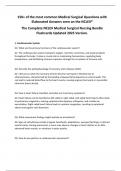Exam (elaborations)
150+ of the most common Medical Surgical Questions with Elaborated Answers seen on the NCLEX® The Complete NCLEX Medical Surgical Nursing Bundle Flashcards Updated 2025 Version.
- Course
- Institution
Endocrine Q1: Which hormone is primarily responsible for regulating blood glucose levels? A) Insulin B) Cortisol C) Thyroxine D) Glucagon Answer: A) Insulin Elaboration: Insulin, produced by the pancreas, lowers blood glucose levels by facilitating the uptake of glucose into the body's cel...
[Show more]



